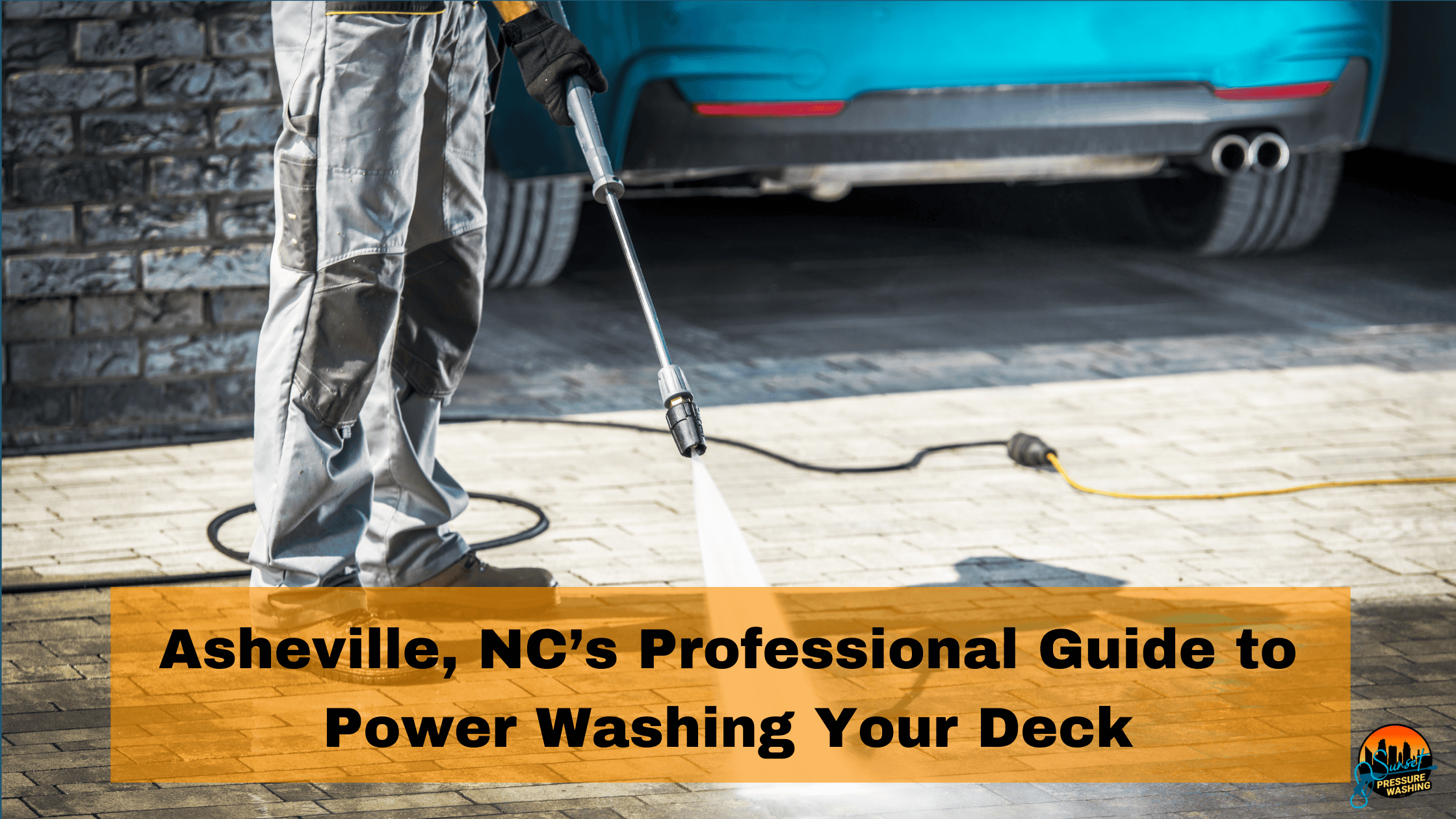
Asheville, NC’s Professional Guide to Power Washing Your Deck
Asheville, with its beautiful mountain views and changing seasons, provides a perfect backdrop for enjoying outdoor living spaces like decks. However, these decks need regular maintenance to stay beautiful and safe. Power washing is a key part of this maintenance. Here’s a professional guide to help you power wash your deck in Asheville, ensuring it remains a pristine part of your home.
Understand the Importance of Deck Maintenance
Proper deck maintenance is crucial for several reasons, particularly in environments like Asheville, NC, where weather can greatly influence the condition of wooden structures. Below are key points that underscore the importance of maintaining your deck, each explained with care:
Preventing Wood Decay and Damage
Regular maintenance, including power washing, helps prevent the wood from decaying. The process removes harmful elements such as moisture, mildew, and mold, which can accelerate wood degradation if left unchecked.
Safety Concerns
A well-maintained deck is a safe deck. Over time, boards may become loose, nails may protrude, and surfaces can become slippery from algae and mold growth. Regular cleaning and inspection ensure these issues are addressed promptly, preventing accidents.
Aesthetic Appeal
A clean deck is visually appealing and can enhance the overall look of your home. Regular power washing removes stains and buildup that can make the wood look old and worn, keeping your deck looking new and inviting.
Pest Prevention
Dirt and grime accumulation can attract insects and pests that may cause further damage to the wood. Keeping the deck clean helps deter these pests and reduces the likelihood of infestation.
Longevity of the Deck
By regularly removing damaging substances and making necessary repairs, you extend the life of your deck. This saves money in the long run, as a well-maintained deck will need fewer major repairs or replacements.
Value Addition
A clean and well-maintained deck adds value to your property. Should you decide to sell, potential buyers will appreciate the care taken in maintaining this part of the home.
Early Detection of Problems
Regular maintenance helps in the early detection of potential problems, such as rotting wood or unstable railings. Addressing these issues early can prevent more significant problems and expensive repairs later.
Preparation for Treatment
Cleaning your deck prepares it for further treatments like staining or sealing. Power washing ensures that these products adhere properly and perform as expected, providing better protection against environmental elements.
Choose the Right Time for Power Washing
Timing is everything when it comes to power washing your deck in Asheville. The right conditions can not only ensure the effectiveness of the cleaning process but also prevent damage to the wood and enhance the deck’s longevity. Here are essential factors to consider when scheduling your deck’s next power wash.
Seasonal Considerations
Spring often provides the perfect conditions for power washing in Asheville. After the winter thaw, it’s crucial to remove any debris and salt residue that may have accumulated, which can erode wood surfaces. Power washing in spring helps prepare the deck for the busy summer season, ensuring it’s clean and safe for use. Moreover, cleaning in spring allows for any necessary repairs before peak deck usage.
Weather Conditions
Choosing a day with warm and dry weather is ideal for power washing. These conditions help the wood dry more uniformly and quickly after washing, minimizing the exposure time to moisture, which can warp and damage the wood. Ensure that the forecast does not predict rain shortly after washing to avoid reintroducing moisture to the freshly cleaned wood.
Direct Sunlight
It is beneficial to avoid power washing in direct sunlight. The sun can cause the water and cleaning solutions to evaporate too quickly, reducing their cleaning efficacy and potentially leaving behind residue. Overcast days, or early mornings or late afternoons when the sun is less intense, are optimal times for power washing.
Humidity Levels
Humidity plays a crucial role in how quickly your deck dries after washing. Opt for a day with low humidity, which will help speed up the drying process. High humidity can prolong the drying time and increase the risk of mold and mildew forming on the wood surface.
Drying Time
Allow sufficient drying time after power washing. This can range from 24 to 48 hours depending on the weather conditions. This step is particularly important if you plan to seal the deck post-washing; applying sealant to a damp deck can trap moisture, leading to wood decay and a compromised sealant bond.
Usage Schedule
Consider your personal or family schedule when planning a power wash. Choose a time when the deck is not in use, allowing for uninterrupted cleaning and drying. This ensures that the process does not interfere with your outdoor activities and provides ample time for any follow-up treatments.
Local Climate Patterns
Be mindful of Asheville’s specific climate patterns. Avoid power washing during rainy seasons or just before winter sets in. Moisture left on the deck can freeze, causing cracks and other structural damages to the wood.
Selecting the Proper Equipment
Choosing the right equipment is essential for effectively power washing your deck without causing damage. Using suitable machinery and accessories can ensure a thorough clean while preserving the integrity of the wood. Here are key considerations to guide you in selecting the proper equipment for power washing your deck.
Type of Pressure Washer
The choice between electric and gas pressure washers depends on the size of your deck and your access to power outlets. Electric washers are usually sufficient for smaller, residential decks and are quieter and easier to handle. Gas pressure washers offer more power and mobility, making them ideal for larger decks or more extensive cleaning tasks.
Pressure Settings
It’s crucial to choose a pressure washer with adjustable pressure settings. Wood decks, especially those made from softer woods, can be damaged by too much pressure. A safe range for most wooden decks is between 500 to 1200 psi. Always start at the lower end of this range and adjust as needed to ensure the wood is not being etched or damaged.
Nozzles and Tips
Different nozzles can greatly affect the intensity and spread of the water jet. A wider angle nozzle (such as 40 degrees) disperses pressure over a broader area, which is safer for deck cleaning and less likely to damage the wood. Avoid using zero-degree nozzles, which can be too harsh and leave marks.
Detergents and Cleaners
Selecting the right cleaners is crucial for effective cleaning and wood care. Opt for biodegradable and eco-friendly cleaners that are specifically designed for use on wood. These cleaners help lift dirt and grime without harming the wood’s natural fibers or the surrounding vegetation.
Hoses and Extensions
For larger decks or those with hard-to-reach areas, ensure your pressure washer has a sufficiently long hose. Extensions can help you reach all parts of the deck without constantly moving the machine, making the cleaning process more efficient and less labor-intensive.
Prepare Your Deck
Proper preparation of your deck before power washing is crucial to ensure the cleaning process is effective and does not damage your outdoor space. Here’s how to ready your deck for a thorough power wash, keeping it beautiful and extending its lifespan.
Clear the Surface
Begin by removing all furniture, grills, planters, and any other items from the deck. This ensures that you have unobstructed access to the entire surface, allowing for a thorough cleaning. It also protects your belongings from water damage and debris.
Sweep and Remove Debris
Use a broom or a leaf blower to sweep away loose debris such as leaves, twigs, and dirt. Pay special attention to the gaps between deck boards, as these areas can accumulate materials that promote moisture retention and mold growth.
Check for Repairs
Inspect the deck for any loose, cracked, or rotten boards. Make sure all nails and screws are flush with the wood surface or consider replacing them with newer, corrosion-resistant fasteners. Addressing these issues before washing can prevent further damage during the cleaning process and ensure your deck remains safe.
Sand Rough Areas
If there are rough patches or splintered areas on your deck, sand them down smoothly. This not only prevents injuries but also helps in achieving a more even clean, as smooth surfaces are easier to wash thoroughly.
Choose the Right Cleaning Solution
Selecting an appropriate cleaning solution is essential for effectively power washing your deck without causing harm to the wood or the environment. Here are the key factors to consider to ensure you choose the best cleaner for your deck’s specific needs.
Consider Wood Type
The type of wood your deck is made from will influence your choice of cleaning solution. Softer woods like cedar require a gentler cleaner to avoid damage, whereas harder woods may withstand stronger solutions. Always check the cleaner’s compatibility with your wood type.
Environmental Safety
Opt for environmentally friendly cleaning solutions that are biodegradable and non-toxic. These cleaners are safer for your plants, pets, and family, and they minimize your environmental footprint. Asheville’s natural surroundings are particularly worth protecting, so choosing eco-friendly products is crucial.
Stain and Sealant Compatibility
If your deck is stained or sealed, make sure the cleaning solution is appropriate for use with these treatments. Some cleaners may strip away or damage existing stain or sealant, necessitating a reapplication. It’s best to use a cleaner that cleans effectively without interfering with your deck’s protective coatings.
Specific Cleaning Needs
Tailor your choice of cleaner to the specific challenges your deck faces. If you’re dealing with mold, mildew, or algae, look for solutions that include components specifically designed to tackle these problems. For general dirt and grime, a standard deck cleaner may suffice.
Concentration and Cost-Effectiveness
Consider the concentration of the cleaning solution. Some concentrated cleaners can be diluted, which offers flexibility depending on the level of cleaning required and can be more cost-effective in the long run.
Application Method
Different cleaners may require different application methods, such as spraying, brushing, or a combination of both. Choose a cleaner that suits your preferred method or the equipment you have available, ensuring that it can be applied evenly and effectively.
Applying the Cleaner
Effectively applying the cleaner is crucial for maximizing the cleaning power of your deck maintenance routine. Here’s a step-by-step guide to ensure the cleaning solution is applied correctly, providing a thorough cleanse without damaging your deck.
Identify the Affected Areas
Before applying any cleaning solution, ensure that your deck is prepped correctly. This includes removing furniture, sweeping debris, and covering any nearby plants or objects that might be affected by the cleaning chemicals.
Mixing the Solution
If you’re using a concentrated cleaner, follow the manufacturer’s instructions to mix it with the appropriate amount of water. This step is crucial to achieve the right chemical potency for effective cleaning without causing harm to the deck’s material.
Testing the Solution
It’s a good idea to test the cleaning solution on a small, inconspicuous area of your deck. This allows you to see how the wood reacts to the cleaner and ensures that it doesn’t discolor or damage the surface.
Applying the Solution
Use a garden sprayer, roller, or a stiff brush to apply the cleaner evenly across the deck. Start from one end and work your way to the other, making sure to cover each area thoroughly. For decks with a lot of mold or mildew, you might need to use a brush to scrub the solution into the wood.
Letting the Cleaner Sit
Allow the cleaner to sit on the deck for the period specified by the product’s instructions—usually between 10 to 15 minutes. During this time, the chemicals break down oils, dirt, and organisms like mold or algae. Avoid letting the cleaner dry completely, as this can make it harder to rinse off and may leave residues.
Scrubbing
For tough stains or areas with significant buildup, use a stiff bristle brush to scrub the deck. This helps the cleaning solution penetrate deeper into the wood and lifts stubborn dirt. Be sure to scrub gently to avoid damaging the wood fibers.
The Washing Technique
Using the right washing technique is crucial for effectively cleaning your deck without causing damage. Proper handling of the pressure washer and appropriate techniques will ensure that the wood is preserved while removing all the built-up grime and residues. Here’s how to properly wash your deck:
Starting with Low Pressure
Begin with the lowest pressure setting that is effective. This approach helps prevent damage to the wood. Gradually increase the pressure only if necessary, and always keep it within the safe range for your deck’s material to avoid gouging or splintering the wood.
Using the Correct Nozzle
Choose a fan nozzle, which disperses the water over a wider area, reducing the impact on any one spot. A 40-degree nozzle is often ideal for deck cleaning, providing enough power to clean effectively while being gentle on the wood.
Consistent Distance and Angle
Maintain a consistent distance of about 6-12 inches between the nozzle and the deck surface. The angle at which you hold the spray gun should be steady and aimed straight at the surface to avoid lifting the wood grain.
Sweeping Motion
Use a controlled sweeping motion when spraying. Move the spray in a consistent pattern and overlap each stroke by about 50% to ensure even cleaning. This method prevents streaks and missed spots.
Section by Section Cleaning
Clean your deck in sections to keep control over the process and ensure thorough coverage. This approach helps you manage the cleaning solution and rinsing more effectively, ensuring no areas dry out with cleaner still on them.
Dealing with Tough Stains
For areas with tough stains, you may need to pass over them multiple times. However, always be cautious with the pressure and angle to avoid wood damage. For extremely stubborn stains, consider applying a spot treatment cleaner and scrubbing gently with a brush before rinsing.
Addressing Tough Stains
Dealing with tough stains on your deck requires special attention and techniques to ensure they are removed effectively without damaging the wood. Here’s a step-by-step approach to tackling these challenging areas during your deck maintenance routine.
Identifying the Stain Type
First, identify the type of stain you’re dealing with. Common tough stains on decks include grease, wine, mold, and mildew. Each type of stain may require a slightly different approach and cleaning solution to effectively remove it.
Choosing the Right Cleaning Agent
Select a cleaning agent specifically formulated for the type of stain and your deck’s material. For organic stains like mold or mildew, use a cleaner with mildewcide. For oil-based stains like grease, a degreaser may be necessary. Always follow the manufacturer’s instructions for application and safety.
Pre-Treatment
Apply the cleaning agent directly to the stained area. Allow it to sit for the recommended time to penetrate and break down the stain. This pretreatment step is crucial for loosening the stain and making it easier to remove.
Scrubbing Techniques
Use a stiff bristle brush to scrub the stained area gently. The physical action of scrubbing helps to lift the stain from the wood fibers. Be cautious not to scrub too hard, as this can damage the wood surface.
Spot Cleaning with Increased Pressure
If the stain persists, consider using a pressure washer with a slightly higher pressure setting or a narrower nozzle for a more focused cleaning action. However, be very careful to keep the washer moving to avoid concentrating the pressure in one spot too long, which can damage the wood.
Reapplication if Necessary
For particularly stubborn stains, a second application of the cleaning agent may be needed. Repeat the application and scrubbing process to further break down and remove the stain.
Thorough Rinsing
After addressing the tough stains, rinse the area thoroughly with clean water. It’s essential to remove all residues of the cleaning agent to prevent it from attracting more dirt or damaging the wood over time.
Enhance Your Deck with Professional Power Washing in Asheville
Maintaining your deck through regular power washing is essential for extending its lifespan and keeping it beautiful, especially in Asheville’s varied climate. Whether you’re tackling mildew, mold, or just annual dirt and debris, a professional power washing service can ensure your deck remains a highlight of your home. If you’re looking for expert care, consider Sunset Pressure Washing, where we offer comprehensive deck cleaning that rejuvenates and protects your outdoor living space. Ready to refresh your deck? Book our services today and enjoy a pristine, well-maintained deck throughout the year!






